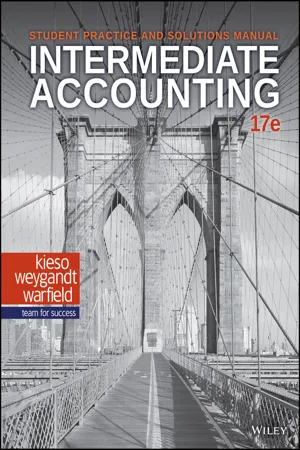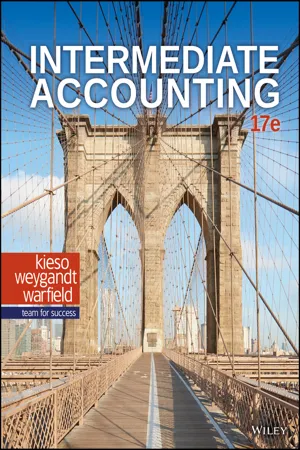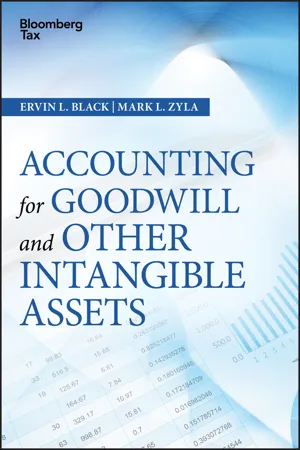Business
Amortization
Amortization refers to the process of spreading out the cost of an intangible asset over its useful life. In the context of business, this is commonly applied to expenses such as patents, copyrights, and trademarks. By amortizing these costs, businesses can accurately reflect the asset's declining value over time and allocate the expense accordingly in their financial statements.
Written by Perlego with AI-assistance
Related key terms
1 of 5
9 Key excerpts on "Amortization"
- Donald E. Kieso, Jerry J. Weygandt, Terry D. Warfield(Authors)
- 2019(Publication Date)
- Wiley(Publisher)
Amortization of Intangibles Intangibles have either a limited (finite) useful life or an indefinite useful life. An intangible asset with a limited life is amortized; an intangible asset with an indefinite life is not amortized. Limited-Life Intangibles The allocation of the cost of intangible assets is called Amortization. Limited-life intangibles should be amortized by systematic charges to expense over their useful life. The useful life should reflect the periods over which these assets will contribute to cash flows. The amount of Amortization expense for a limited-life intangible asset should reflect the pattern in which the asset is consumed or used up, if that pattern can be readily determined. *Note: All asterisked (*) items relate to material contained in the Appendices to the chapter. 12-2 CHAPTER 12 Student Practice and Solutions Manual If not, the straight-line method of Amortization should be used. When intangible assets are amortized the charges should be shown as expenses, and the credits should be made either to the appropriate asset accounts or to separate accumulated Amortization accounts. The amount of an intangible asset to be amortized should be its cost less residual value. Indefinite-Life Intangibles If no legal, regulatory, contractual, competitive, or other factors limit the useful life of an intangible asset, the useful life is considered indefinite. An intan- gible with an indefinite life is not amortized, instead it is tested for impairment at least annually. LO 2: Discuss the accounting for various types of intangible assets. Marketing-Related Intangible Assets Marketing-related intangible assets are those assets primarily used in the marketing or promotion of products or services. Examples are trademarks or trade names, newspaper masthead, Internet domain names, and noncompe- tition agreements. A trademark or trade name is a word, phrase, or symbol that distinguishes or identifies a particular enterprise or product.- eBook - PDF
- Donald E. Kieso, Jerry J. Weygandt, Terry D. Warfield(Authors)
- 2019(Publication Date)
- Wiley(Publisher)
How do companies justify this approach? Some argue that the costs incurred internally to create intangibles often bear no relationship to their real value. Therefore, they reason, expensing these costs is appropriate. Others note that it is difficult to associate internal costs with a specific intangible. Still others contend that due to the underlying subjectivity related to intangibles, companies should follow a conservative approach—that is, expense as incurred. As a result, companies capitalize only direct costs incurred in developing the intangible, such as legal costs, and expense the rest. Amortization of Intangibles The allocation of the cost of intangible assets in a systematic way is called Amortization. Intangibles have either a limited (finite) useful life or an indefinite useful life. For ex- ample, a company like Walt Disney Company has both types of intangibles. Disney amor- tizes its limited-life intangible assets (e.g., copyrights on its movies and licenses related to its branded products). It does not amortize indefinite-life intangible assets (e.g., the Disney trade name or its Internet domain name). Limited-Life Intangibles Companies amortize their limited-life intangibles by systematic charges to expense over their useful life. The useful life should reflect the periods over which these assets will contribute to cash flows. Disney, for example, considers these factors in determining useful life: 1. The expected use of the asset by the company. 2. The expected useful life of another asset or a group of assets to which the useful life of the intangible asset may relate (such as lease rights to a studio lot). 3. Any legal, regulatory, or contractual provisions that may limit the useful life. Underlying Concepts The controversy sur- rounding the accounting for R&D expenditures reflects a debate about whether such expendi- tures meet the definition of an asset. - No longer available |Learn more
- Joseph B. Darby(Author)
- 2017(Publication Date)
- The National Underwriter Company(Publisher)
Amortization OF INTANGIBLES—CODE SECTION 197CHAPTER 11OVERVIEWIntangible property is the driving engine of the U.S. economy and much of the international economy. Studies have shown that whereas thirty or forty years ago, intangible property represented approximately 30 percent of the total value on the balance sheet of a typical corporation, today it represents on average an estimated 70 percent of the total value. This reflects the fact that the modern economy no longer creates wealth with large amounts of expensive tangible property, but rather relies on intangible assets. In effect, steel mills and shoe factories have been replaced with patents, trademarks, know-how, goodwill, and other similar “assets.” Given recent trends in history, it seems likely that this evolution and direction will continue well into the future.The tax treatment of intangibles has developed, rather belatedly, as intangibles have surged in importance. Before the Revenue Reconciliation Act of 1993 (P.L. 103-66), Amortization of intangibles was a major source of litigation between taxpayers and the IRS. Under prior law, “goodwill” was not considered amortizable for income tax purposes based on the IRS’s position, asserted in regulations, that goodwill does not have a useful life that can be estimated with reasonable certainty. Therefore, the regulations mandated that no deduction was allowable with respect to goodwill.1 However, because taxpayers are loath to pay good money for a non-amortizable or non-depreciable asset, various efforts—often highly creative—were made to identify specific assets, within the category of goodwill, which had a reasonably determinable useful life. See, e.g., the Supreme Court case of Newark Morning Ledger Co.,2 - eBook - PDF
- Donald E. Kieso, Jerry J. Weygandt, Terry D. Warfield(Authors)
- 2016(Publication Date)
- Wiley(Publisher)
When a company makes a “basket purchase” of several intangibles or a combination of intangibles and tangibles, it should allocate the cost on the basis of fair values. Intangibles have either a limited useful life or an indefinite useful life. Companies amortize limited-life intangibles. They do not amortize indefinite-life intangibles. Limited-life intangibles should be amortized by systematic charges to expense over their useful life. The useful life should reflect the period over which these assets will contribute to cash flows. The amount REVIEW AND PRACTICE KEY TERMS REVIEW Amortization, 613 bargain purchase, 622 business combination, 612(n) copyright, 616 development activities, 628 fair value test, 623 franchise, 617 goodwill, 619 impairment, 622 indefinite-life intangibles, 613 intangible assets, 612 license (permit), 617 limited (finite)-life intangibles, 613 master valuation approach, 621 organizational costs, 631 patent, 617 recoverability test, 623 research activities, 628 research and development (R&D) costs, 628 start-up costs, 631 trademark, trade name, 615 Practice Problem 635 to report for Amortization expense should reflect the pattern in which a company consumes or uses up the asset, if it can reliably determine that pattern. Otherwise, use a straight-line approach. 2 Describe the accounting for various types of intangible assets. Major types of intangibles are (1) marketing-related intangibles, used in the marketing or promotion of products or services; (2) customer-related intangibles, resulting from interac- tions with outside parties; (3) artistic-related intangibles, giving ownership rights to such items as plays and literary works; (4) contract-related intangibles, representing the value of rights that arise from contractual arrangements; (5) technology-related intangibles, relating to innovations or technological advances; and (6) goodwill, arising from business combinations. - eBook - PDF
- Donald E. Kieso, Jerry J. Weygandt, Terry D. Warfield(Authors)
- 2020(Publication Date)
- Wiley(Publisher)
The useful lives should reflect the period over which these assets will contribute to cash flows. The amount to report for amor- tization expense should reflect the pattern in which a company con- sumes or uses up the asset, if it can reliably determine that pattern. Otherwise, use a straight-line approach. 2 Describe the accounting for various types of intangi- ble assets. Major types of intangibles are (1) marketing-related intangi- bles, used in the marketing or promotion of products or services; (2) customer-related intangibles, resulting from interactions with out- side parties; (3) artistic-related intangibles, giving ownership rights to such items as plays and literary works; (4) contract-related intan- gibles, representing the value of rights that arise from contractual arrangements; (5) technology-related intangibles, relating to innova- tions or technological advances; and (6) goodwill, arising from busi- ness combinations. 3 Explain the accounting issues for recording goodwill. Unlike receivables, inventories, and patents that a company can sell or exchange individually in the marketplace, goodwill can be identified only with the company as a whole. Goodwill is a “going concern” valuation and is recorded only when an entire busi- ness is purchased. A company should not capitalize goodwill generated internally. The future benefits of goodwill may have no relationship to the costs incurred in the development of that good- will. Goodwill may exist even in the absence of specific costs to develop it. To record goodwill, a company compares the fair value of the net tangible and identifiable intangible assets with the purchase price of the acquired business. The difference is considered goodwill. Good- will is the residual. Goodwill is often identified on the statement of financial position as the excess of cost over the fair value of the net assets acquired. 4 Identify impairment procedures and presentation requirements for intangible assets. - eBook - ePub
- (Author)
- 2023(Publication Date)
- Wiley(Publisher)
Intangible assets refer to identifiable non-monetary assets without physical substance. Examples include patents, licenses, and trademarks. For each intangible asset, a company assesses whether its useful life is finite or indefinite.An intangible asset with a finite useful life is amortized on a systematic basis over the best estimate of its useful life, with the Amortization method and useful life estimate reviewed at least annually. Intangibles are subject to impairment as well, in a similar manner to tangible assets like property, plant, and equipment.- An intangible asset with an indefinite useful life is not amortized. Instead, it is tested for impairment at least annually.
For internally generated intangible assets, the International Financial Reporting Standards (IFRS) require that costs incurred during the research phase must be expensed. Costs incurred in the development stage can be capitalized as intangible assets if certain criteria are met, including technological feasibility, the ability to use or sell the resulting asset, and the ability to complete the project.The most common intangible asset that is not a separately identifiable asset is goodwill, which arises in business combinations. Goodwill is not amortized; instead it is tested for impairment at least annually.Financial instruments are contracts that give rise to both a financial asset of one entity and a financial liability or equity instrument of another entity. In general, financial instruments are measured in two ways: fair value or amortized cost. For financial instruments measured at fair value, the two basic alternatives in how net changes in fair value are recognized are (1) as profit or loss on the income statement, or (2) as other comprehensive income (loss) that bypasses the income statement. - eBook - PDF
- Jerry J. Weygandt, Donald E. Kieso, Paul D. Kimmel, Barbara Trenholm, Valerie Warren, Lori Novak(Authors)
- 2016(Publication Date)
- Wiley(Publisher)
Under ASPE, this annual test is not required unless indicators are present. ASPE Identify the basic accounting issues for intangible assets and goodwill. LEARNING OBJECTIVE 6 Intangible Assets and Goodwill CHAPTER 9 497 Similar to tangible assets, the Amortization is revised if there are changes in cost or useful life, or an impairment loss. At disposal, just as with tangible assets, the carrying amount of the intangible asset is removed, and a gain or loss, if any, is recorded. INTANGIBLE ASSETS WITH FINITE LIVES Examples of intangible assets with finite lives include patents and copyrights. We also include research and development costs in this section because these costs often lead to the creation of patents and copyrights. Patents A patent is an exclusive right issued by the Canadian Intellectual Property Office of Industry Canada that allows the patent holder to manufacture, sell, or otherwise control an invention for a period of 20 years from the date of the application. A patent cannot be renewed. But the legal life of a patent may be extended if the patent holder obtains new patents for improvements or other changes in the basic design. The initial cost of a patent is the price paid to acquire it. After it has been acquired, legal costs are often incurred. Legal costs to successfully defend a patent in an infringement suit are considered neces- sary to prove the patent’s validity. They are added to the Patent account and amortized over the patent’s remaining life. The cost of a patent should be amortized over its 20-year legal life or its useful life, whichever is shorter. As mentioned earlier in this chapter, the useful life should be carefully assessed by considering whether the patent is likely to become ineffective at contributing to revenue before the end of its legal life. Copyrights A copyright is granted by the Canadian Intellectual Property Office, giving the owner an exclusive right to reproduce and sell an artistic or published work. - eBook - PDF
Financial Accounting Theory and Analysis
Text and Cases
- Richard G. Schroeder, Myrtle W. Clark, Jack M. Cathey(Authors)
- 2022(Publication Date)
- Wiley(Publisher)
1. Those having a term of existence limited by law, regulation, or agreement, or by their nature (such as patents, copyrights, leases, licenses, franchises for a fixed term, and good- will as to which there is evidence of limited duration) 36 Accounting Principles Board, APB Opinion No. 17, “Intangible Assets” (New York: AICPA, 1970) (superseded). 37 Ibid., para. 24. 367 Transfers of Financial Assets 2. Those having no such term of existence and as to which there is, at the time of acquisition, no indication of limited life (such as goodwill generally, going value, trade names, secret processes, subscription lists, perpetual franchises, and organization costs) 38 This release resulted in the adoption of a classification scheme that identified intangibles as either “type (a)” or “type (b),” and these terms became widely used in discussing the issues asso- ciated with recording and amortizing intangible assets. In fact, in APB Opinion No. 17, these concepts were specifically used in the discussion of the present practice of cost allocation for intangible assets. In this release, the APB described that the cost of type (a) intangible assets were commonly amortized to income over the term or existence of other period expected to receive benefit. The treatment for type (b) intangible assets followed one of two alternatives. In some cases, the cost was retained on the balance sheet until a point in time where the limit on the term was identified or until a loss of value was evident. At this point in time, the cost was to be amortized over the remaining life or, in the case of a loss of value, the cost was to be written off in the period that the loss was identified. The alternative treatment was an Amortization over an arbitrary period of time. - Ervin L. Black, Mark L. Zyla(Authors)
- 2018(Publication Date)
- Wiley(Publisher)
CHAPTER 3 Amortizing Intangible AssetsLike goodwill, some intangible assets have indefinite lives. An intangible asset is considered to have an indefinite life if the entity finds that there are no “legal, regulatory, contractual, competitive, economic, or other factors” that limit its useful life.1 However, indefinite life does not mean infinite for the purposes of ASC 350-30;2 it simply means the benefits from an intangible asset extend beyond the foreseeable future.3 According to the FASB, most intangible assets have finite lives.4 Intangible assets with indefinite lives and goodwill are not amortized, except for goodwill acquired by a private company.5When an intangible asset has a finite life, its remaining useful life must be estimated, and its carrying amount must be amortized over that remaining useful life using an appropriate Amortization method.A. Determining the Estimated Useful Life
The estimated useful life of an intangible asset to an entity is the period over which the asset is expected to contribute either directly or indirectly to the entity's cash flows.6 A customer list is an example of an intangible asset that contributes directly to an entity's cash flows and a non-compete agreement is an example of an intangible asset that contributes indirectly to an entity's cash flows (by allowing the entity to retain customers that a past employee otherwise might entice away from the entity).The FASB has identified six general factors to guide constituents when determining the useful life of an intangible asset. These factors must be analyzed within the context of the previous definition of estimated useful life. The FASB's factors are:7- The expected use of the asset by the entity.
Comment
Generally, the expected use of the asset by the entity means the length of time the asset is expected to generate cash flows for the entity. Therefore, if the entity measured the asset using a discounted cash flow approach, it should consider the length of the cash flows used in the measurement when determining the asset's useful life.
Index pages curate the most relevant extracts from our library of academic textbooks. They’ve been created using an in-house natural language model (NLM), each adding context and meaning to key research topics.








